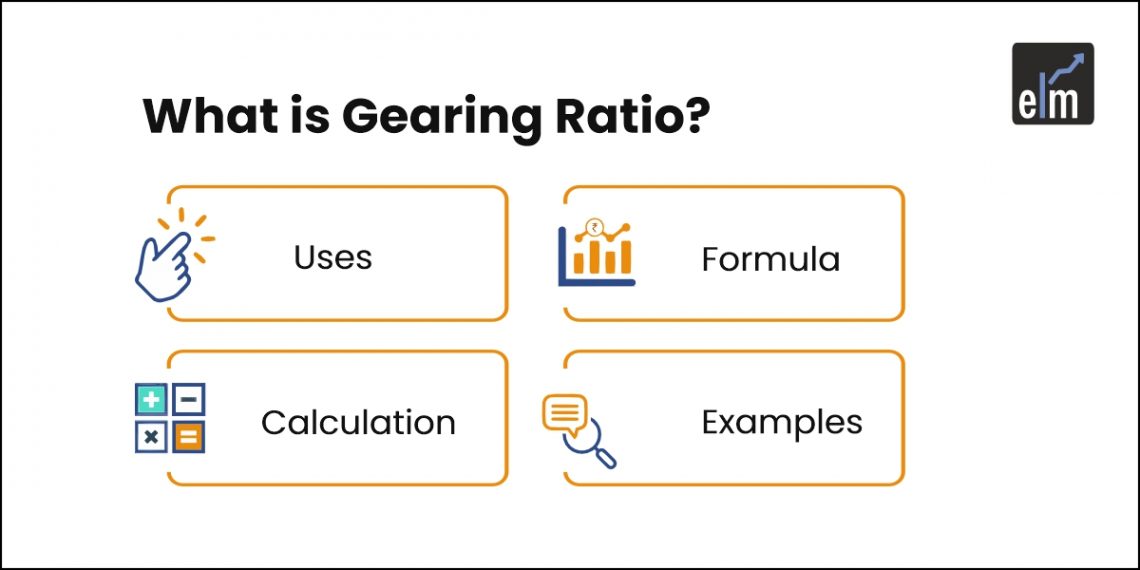Gearing ratio helps us in assessing how much financial leverage a company has. This important financial metric displays the ratio of a company’s debt to equity capital. The ratio shows how much debt or equity is used to fund a business’s operations.
Investors and analysts can better comprehend a company’s financial standing and capacity to pay its debts by examining its gearing ratio. Lenders and investors frequently use this ratio to evaluate a company’s creditworthiness and future loan repayment capacity.
In this regard, a company’s creditworthiness and general financial stability are significantly influenced by its gearing ratio.
Let us discuss about this ratio in detail:
Table of Contents
What is the Gearing Ratio?
The gearing ratio, or leverage ratio, assesses how much financial leverage a corporation has. By examining the percentage of debt and equity funding, it is used to evaluate the company’s long-term solvency.
Said another way, this ratio expresses the ratio of a company’s debt to equity or funds from shareholders. It shows how much of the company’s activities are financed by external debt and is given as a percentage or ratio.
Formula
One financial statistic used to assess a company’s level of financial leverage is the net gearing ratio. It contrasts the total amount of debt—which includes bank overdrafts and long—and short-term debt—with the total amount of shareholders’ equity.
The formula is:
Net Gearing Ratio = (Long-Term Debt + Short-Term Debt + Bank Overdrafts) / Shareholders’ Equity
Calculation Example
Let us understand this ratio calculation with an example-
Suppose the company ABC has the following financials-
Total Debt: Rs. 500,000
Shareholders’ Equity: Rs. 1,000,000
Thus, the atio= 500000/1000000 = 0.5
Interpretation-
This means for every Re. 1 of equity; the company has Re. 0.50 of debt. A ratio of 50% indicates a moderate level of financial leverage.
What is a Good Gearing Ratio?
A low ratio suggests that the company is employing more equity financing, whilst a high ratio shows that the company is significantly depending on debt financing to fund its operations.
It is widely accepted that a reasonable degree of gearing is preferable since it indicates a harmony between the utilization of debt and equity funding.
A ratio of more than fifty per cent indicates that the company has a large debt load relative to its equity.
Given the company’s propensity for loan defaults and bankruptcy, especially during recessions or times of high interest rates, this is frequently regarded as a high-risk situation.
A high ratio suggests that the company needs to borrow a large amount of money to sustain its operations, which could further strain its cash flow.
What are the uses of the Gearing Ratio?
Here are some of the uses of this ratio-

1. By Lenders
An essential statistic used by creditors and lenders to assess a company’s creditworthiness is the gearing ratio.
As we discussed above, a high ratio could indicate a higher default risk, which could make it harder for a business to get funding or good loan terms. In contrast, a low ratio indicates a lesser default risk, which may attract lenders and creditors to a corporation.
2. By Investors
By giving an indication of a company’s leverage, the ratio aids analysts and investors in evaluating the financial risk associated with it.
An elevated ratio signifies that the organization possesses a substantial debt load in comparison to its equity, hence augmenting its financial risk and susceptibility to fluctuations in interest rates and macroeconomic circumstances.
Conversely, a low ratio denotes a less dependent financial structure on debt financing and is more prudent.
3. Comparison tool
When comparing businesses in the same sector or industry, this ratio is helpful.
Comparing organizations can reveal which ones are more or less indebted in contrast to their peers because identical operations and revenue streams should result in similar gearing ratios
4. Planning capital structure
A crucial tool for businesses to consider when organizing their capital structure. This ratio can be used by a business to evaluate the effects of issuing more shares or taking on more debt.
A business can create a capital structure that strikes a balance between its demand for funding and its tolerance for financial risk by examining various situations and how they affect th ratio.
For market updates, visit StockEdge
Frequently Asked Questions (FAQs)
How do gearing ratios work?
A financial measure called a gearing ratio contrasts the debt of an organization with the capital, or shareholders’ equity. Net gearing, which is computed by dividing total debt by total shareholders’ equity, is the most prevalent kind of gearing ratio. The ratio, which is given as a percentage, shows how much equity in a business would be required to settle its debt.
How to reduce gearing ratio?
By paying off their debts, businesses can lower their gearing ratio. There are several approaches to accomplish this, such as: selling stock. increasing shareholder equity through the issuance of additional shares to the public, which can be utilized to settle the company’s debt.
Is a 30% gearing ratio good?
25% to 50% is thought to be the ideal ratio. It shows that a business is fiscally prudent and consistently aims to finance its operations in a way that strikes a good balance between debt and shareholder equity.
Conclusion
One important financial indicator for assessing a company’s financial health is the gearing ratio. It offers insightful information on the ratio of equity to debt in a company’s capital structure. Debt financing is one way for a business to raise money for growth and expansion. The amount of debt that a business can take on without endangering it is determined in part by gearing ratios. Tax deductions for debt interest can reduce an organization’s after-tax profits and tax liability.







